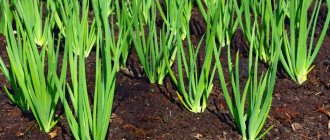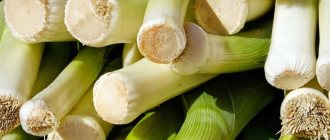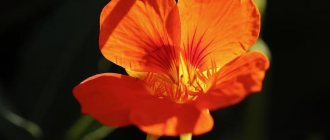We are accustomed to the fact that our radish is a spicy, pungent-tasting, vitamin-rich vegetable. But the culture also has a less vigorous, but no less useful variety - daikon or Japanese radish. It is tender, juicy, slightly sweet, piquant. Planting and caring for daikon has its own characteristics - in amateur gardens, the vegetable is often grown as a second crop, the roots of which are an excellent alternative to autumn radishes, and they are also stored well in winter.
To understand how to plant daikon correctly, we suggest understanding its biological characteristics and nuances of agricultural technology.
“Big root” is a tasty, healthy, low-calorie product, the main vegetable of Japanese cuisine.
Popular varieties of daikon
In Japan, the homeland of daikon, where plantings of the vegetable occupy the first place in the world in terms of area, there are more than 400 varieties of it. In Russia, the range of this crop is much more modest, but still, those vegetable growers who want to grow white radish should pay attention to the characteristics of the main groups of daikon varieties according to the shape and degree of penetration of root crops into the soil.
- Shogoin - root vegetables are very thick (up to 20 cm in diameter), round or flat-round in shape, grow well in heavy soils. 1/4-1/5 deepened into the ground.
- Sirogari - are distinguished by the optimal size of cylindrical root crops, which reach a length of up to 30 cm and a diameter of up to 7 cm. They protrude 2/3-3/4 above the soil surface.
- Miyashige are long (up to 50 cm) and thick (up to 9 cm) cylindrical root crops, half immersed in the ground.
- Tokinashi - suitable for growing on loamy soils. The shape is similar to the previous variety, but shorter in length.
- Nerima is a group of varieties with smooth and long root crops (up to 70 cm), spindle-shaped, up to 10 cm thick. They protrude 1/4-1/3 above the ground surface.
- Ninengo is a cold-resistant and flower-resistant variety that forms a root crop up to 40 cm in length and up to 6.5 cm in thickness, completely immersed in the ground.
Among the common varieties in Russia you can choose:
- Daikon variety Minowasi is mid-season, resistant to diseases and drought. The root is cylindrical, with a conical tip. Up to 50 cm in length, reaches a weight of up to 1.5 kg. The pulp is white. Productivity 10-13 kg/m2.
- Dragon is a mid-season variety, the root crop is cylindrical, with a conical tip, weighing up to 1 kg. It grows up to 30-60 cm, reaches a thickness of up to 8 cm. The pulp is white, with a dense structure. Productivity 5-7 kg/m2.
- Dubinushka is a mid-season variety that produces a root crop up to 45 cm long, up to 8 cm thick, and weighs up to 2.5 kg. The pulp is snow-white. Productivity, like that of the Dragon variety, is 5-7 kg/m2 when cultivated in open ground.
- Elephant tusk is a mid-season variety (ripening period 70-90 days), forms an elongated cylindrical root crop, up to 50 cm long and weighing 0.3-0.5 kg. Immersed in the soil by 2/3, its flesh is white, juicy, and has no pungent taste. Productivity 3-4 kg/m2
- Sasha is an early-ripening variety of daikon, round in shape (up to 10 cm in diameter), weighing up to 400 g. The pulp is white, without bitterness or pungency. Resistant to bacteriosis. The yield of this variety is 1.5-3.5 kg/m2.
- Sugar rose is early ripening, cold-resistant, very productive. The root vegetables are uniform, round, up to 10 cm thick. The pulp is pink, sweet, tender, and retains an excellent taste for a long time. The yield of this daikon is 1.5-3 kg/m2.
Daikon seeds are distributed by Russian seed companies Gavrish, Aelita, SeDeK. They have been producing certified good quality products for many years.
Time to sow seeds for seedlings in spring
The timing of sowing is influenced by climatic conditions and the place where the daikon will grow in the future: in an open bed or greenhouse.
Being a cold-resistant crop, adult radish is not afraid of low temperatures (around 0 degrees). But the seedlings are planted in the vegetable bed when the spring frosts end and the soil warms up.
By this time, the seedlings should be 1-1.5 months old. If you calculate the days of sowing, then the seeds for seedlings should be sown in the first ten days of April for the countries: Belarus, Ukraine, central Russia.
In Kuban and the Lower Volga region, you can sow daikon seedlings after March 10. When growing root crops in a greenhouse, the timing of sowing depends on the design: if you have a heated greenhouse, then there is no point in seedlings. Seeds can be sown at any time of the year. But it is necessary to plant daikon seedlings in an unheated greenhouse when the temperature inside the structure is not lower than +10 degrees. Counting from the approximate period of 30-35 days, they begin sowing seeds at home.
When to plant daikon in open ground with seeds - planting dates
Like radish, daikon is a short-day plant, so it can only be sown during the period when the day length does not exceed 14 hours. Otherwise, it will throw out the shoot to the detriment of root crops, which may not form. This happens especially often in cool and dry years. That is why it is so important to choose the optimal planting time so that you can count on a harvest of root crops and not flower stalks.
The timing of planting Japanese radish can vary depending on when the grower wants to get the harvest. If you need early production, then you can sow daikon in the spring, as soon as it gets warm enough and the air temperature rises above +5...+10 °C. But it is best to plant this vegetable in the second half of July - early August, at which time the days will become shorter again.
It can be sown in those beds where early vegetables such as potatoes, garlic or onions previously grew. In the central zone and in the northern regions, preference should be given to early and mid-ripening varieties. In the Urals, it is better to sow daikon in the summer rather than in the spring, since with spring sowing the root crops do not have time to form until June and the plants begin to bloom.
Tricks of agricultural technology
The ripening period of the root crop is very short, within a month, therefore, with the correct calculation of planting time, it is possible to harvest 2 crops per season. The first planting occurs in the last week of April or early May. But for storing and obtaining juicier fruits, the second sowing is much more interesting - in the first days of August. Advantages:
- milder weather, without severe drought;
- pest activity is lower;
- less likely to form arrows;
- After harvesting, it can be immediately stored for long-term storage.
It is better to plant it in empty areas after potatoes, tomatoes, herbs, and beans. The location is changed annually to prevent soil depletion. The choice of seeds is very large; there are varieties and hybrids on sale. The most popular: Minowasi, Big Luck F1, Sasha, Dragon, Dubinushka, Emperor, Caesar.
It is worth considering: the earth is dug up twice, all lumps are broken, the soil must be homogeneous, since the correct shape of the fruit depends on this.
Features of growing daikon in open ground
To grow daikon in the country, you will need preferably loamy or sandy loam soil, but clay soils are also suitable for some varieties. It is mainly grown from seeds, but vegetables can also be grown from seedlings. In this case, the root crops will grow faster. To grow daikon in open ground, you will need to prepare the soil and seeds for sowing.
Soil preparation
Soil preparation is a must. In well-fertilized soil, daikon turns out to be large, characteristically shaped, tasty and juicy. In soil depleted after the predecessor, the root crops will be smaller and of poor quality.
For early spring planting of daikon, the soil is prepared in the fall, and for summer planting it can be prepared in the spring, some time before the event. You should dig up the soil well, no less than a spade's length, fill the soil with well-rotted compost or humus in the amount of 1-1.5 buckets per m2 or 50 g of superphosphate and 20 g of potassium salt for the same area. It is not recommended to use fresh manure; alternatively, you can apply it under predecessors.
If the soil is acidic, then it must be limed, since daikon needs slightly acidic and neutral soils. Neutralize the soil in the fall, even before digging and fertilizing, by adding slaked lime. If this was not possible, then you can get by by adding 2 cups of ash per m2 of beds. It will not only alkalize the soil, but will also be a source of elements necessary for plants.
Since daikon root crops grow quickly and are of good size, it is important to take care of the density of the soil. For white radish, light and loose soils are best suited, in which long roots can penetrate deep without obstruction. If the soil on the site is dense and heavy, then it is better to choose varieties with round roots.
Sowing technology
Planting daikon in open ground is carried out in an area where cruciferous vegetables have not previously grown: all types of cabbage, mustard, radish, turnips, which pull the same elements from the soil and are prone to the same diseases.
The best predecessors for it will be tomatoes, potatoes, onions, cucumbers, and garlic. Seeds can be sown dry, but for better germination you can:
- moisten – wrap in a damp cloth and leave in a warm place for 1 day;
- soak - leave for 1 day in warm water;
- stratify - first keep in warm water for 30 minutes, then cool in cold water and put in the refrigerator for a day.
After this, the seeds are ready for planting.
Japanese radish requires a large feeding area to form a full-fledged harvest. Therefore, you can plant daikon seeds according to the following scheme:
- 30x30 cm - for varieties with small root crops;
- 40x40 cm – for varieties with long roots;
You need to sow 2-3 seeds in each hole. to a depth of 1.5 cm, sprinkle them with earth, mulch with peat and cover with film or agrofibre until germination. When the seeds sprout, you need to leave one of the most developed plants in the hole and remove the other.
Harvest and storage
The timing of harvesting daikon radish directly depends on the variety planted. As a rule, the harvest is harvested 40-70 days after planting. Root crops sown in autumn are recommended to be collected in October, before the onset of stable frosts. You should not leave ripe fruits in the ground for a long time, as they can lose their taste characteristics. For cleaning, it is better to choose a day with dry weather, without precipitation.
A crop planted in light soil can be pulled out by the leaves, but in other cases you will need to use a shovel or pitchfork. After removing the root crops from the soil, it is worth drying them, clearing them of lumps of earth, cutting off the tops and storing them. In the room where the fruits will be left, the temperature must be maintained in the range from 0 to 5 degrees. It is recommended to place the crops in boxes with sand so that the root crops do not come into contact with each other.
Planting daikon before winter
White radish is a cold-resistant plant, so it can be grown from seeds in the winter. This is very convenient, because the vegetable can be sown in the fall in areas vacated by other crops, and not have to worry about correctly guessing the timing of spring sowing. Such planting will be especially relevant in the southern regions with a short spring.
Naturally, for pre-winter sowing, you need to take only early ripening varieties and sow the seeds more densely in order to guarantee seedlings after winter (the seed rate is doubled compared to spring-summer sowings). Daikon should be sown before frost; the beds must be completely ready for sowing: dug up, fertilized, holes marked. After sowing, you need to cover the seeds with soil and mulch the ridges with peat, humus, dry soil, leaves, straw, sawdust, and hay. In the spring, after the arrival of warmth, the mulch is removed so that the sun's rays and air begin to penetrate to the plants. The advantage of this sowing option is that it gives the earliest harvest from strong and robust plants.
We recommend reading
What is rutabaga and how to grow it
Useful properties and contraindications for consuming daikon
What is parsnip, its cultivation and care features
How to grow rhubarb in open ground
Daikon care
Japanese radish is an unpretentious plant; it is content with standard care. The main thing is to provide the vegetables with good watering and nutrition, because without this there will be no root vegetables. In cool weather, you need to water the daikon approximately once every 5 days, in hot weather - much more often, so that the soil does not dry out. In dry soil, root vegetables will be tough, lose their juiciness and taste, and their quality will decrease.
After each watering, the soil around the plants must be loosened so that it does not become compacted. You can also hill up a little if after irrigation the soil around the vegetables has eroded. During the loosening process, weeds are also removed, so there is no need for special weeding. You can also mulch the soil with plant material once the plants have grown enough.
It is necessary to feed daikon 2 times during the growing season. The first time fertilizer is applied when 3-4 leaves appear, the second time - with a break of 2-3 weeks. Organic and mineral fertilizers are used.
Diseases and pests of daikon - combating them
Diseases and pests of white radish are the same as those of other cruciferous vegetables. Many of them are the result of disturbances in the cultivation of plants by the vegetable grower himself. For example, on waterlogged soil, daikon develops mucous and vascular bacteriosis. To prevent this disease, when preparing seeds, in addition to standard procedures, it is necessary to treat them with the biological product Planriz or carry out the treatment after sowing the plants.
Pests of daikon are cruciferous flea beetle, cabbage white fly, fly and cutworm. They are destroyed by infusion of tobacco, hot pepper, and by applying ash to wet plant leaves. To repel pests, marigolds are planted around daikon beds, the smell of which insects cannot tolerate.
Alternatively, you can grow vegetables throughout the growing season under non-woven material. This will not only prevent pest attacks, but also get the harvest faster.











